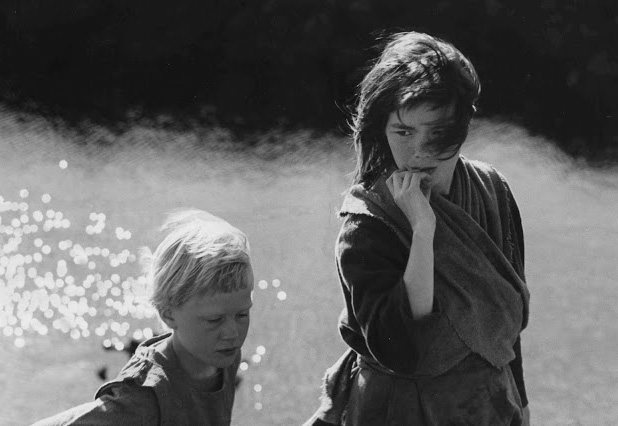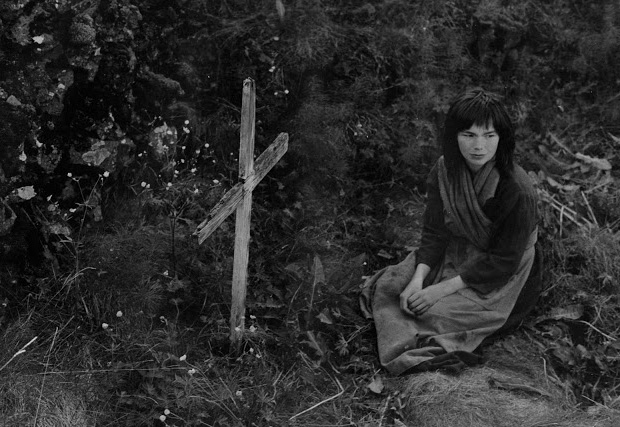THE JUNIPER TREE + SHADOW PANIC






8:45 PM, Friday October 15
Classic Cinemas, Elsternwick
Introduced by Robin Laurie
Director: Nietzchka Keene (The Juniper Tree), Margot Nash (Shadow Panic)
Country: Iceland, Australia
Year: 1989
Runtime: 103 minutes total
Language: English, Icelandic [Engl subs]
Format: Colour/B&W, Sound
Rating: CTC
Classic Cinemas, Elsternwick
Introduced by Robin Laurie
Director: Nietzchka Keene (The Juniper Tree), Margot Nash (Shadow Panic)
Country: Iceland, Australia
Year: 1989
Runtime: 103 minutes total
Language: English, Icelandic [Engl subs]
Format: Colour/B&W, Sound
Rating: CTC
Tickets⟶
A hit on its premiere at Sundance, Nietzchka Keene’s stark, stunning debut feature The Juniper Tree (1989) is also the first film for Icelandic singer Björk (billed here by her full name, Björk Guðmundsdóttir). Set in medieval Iceland and adapted from a tale by the Brothers Grimm — one of the gnarly unexpurgated ones, this feminist retelling follows the story of two sisters, Katla (Bryndis Petra Bragadóttir) and Margit (Björk), who find themselves homeless after their mother is burned to death for witchcraft.
Presented in a new 4K restoration
Preceded by Margot Nash’s award-winning experimental film, Shadow Panic (1989). Three women’s world’s collide by chance. A short innovative drama about internal and external states of emergency; personal and collective shadows; resistance and spirit. In 2020, this feminist classic was restored from the original 16mm film materials.
Presented in a new 4K restoration
Preceded by Margot Nash’s award-winning experimental film, Shadow Panic (1989). Three women’s world’s collide by chance. A short innovative drama about internal and external states of emergency; personal and collective shadows; resistance and spirit. In 2020, this feminist classic was restored from the original 16mm film materials.
Notes on The Juniper Tree by Helen Gotitsas:
The Film
Nietzchka
Keen’s, The Juniper Tree is an astonishingly atmospheric work. With a
cast of only five actors, heralding from a strong Icelandic theatre tradition,
Keene composes a lyrical and dreamlike medieval fantasy that is both barbaric
and poetic.
Reciting songs translated from original old Icelandic melodies about St Veronica and St Ursula, chanting spells and incarnations from the turn of the century, “Out from here out from there” and employing biblical readings and rhymes written to fit the occasion using the Icelandic sagas form, the power of belief, fuelled by superstition and black magic in a time of persecution is evoked. Keene augments this within a primitive, harsh and brutal reality, where the fear of death and loss of connection, must be endured.
Diverting from the original Grimm storyline in this feminist reinterpretation, Keene foregrounds the negative depiction of feminine power and explores the misogynistic fear of womanhood as an evil doer in medieval folklore. Women practicing folk medicine once sought out for their healing abilities and intuition were at the height of the hysteria of the middle ages, demonised as witches. An underlying archetype in the gender-based hierarchy of many of the Brothers Grimm fairy tales.
Keene’s retelling is told from the point of view of Margit, played wondrously by 21-year-old Björk (Bjork Guðmundsdóttir) a recent mother and new member of the Sugercubes. Margit on the precipice of womanhood possesses the gift of second sight. Her older sister Katla (Bryndis Petra Bragadottir) and she, flee their home in desperation after their mother, (Guðrún Gísladóttir) and other women of their kind are condemned for practicing witchcraft. Gruesomely executed. Stoned, drowned and or burned to death.
Seeking refuge Katla seduces a recently widowed father Jóhann (Valdimar Örn Flygenring) from a faraway farm, with a love spell, so that she can become his wife and keep them safe. Requiring the protection of a man, Keene portrays this belief and act of sorcery as one of survival.
The farmer’s little boy Jonas (Geirlaug Sunna Þormar), grieving the recent loss of his mother, resents his new stepmother and implores his father to make her leave. Feeling threatened Katla continues to make potions and perform incarnations to lure and hold on to her new husband. This ill will finally turns perilously ominous when the little boy accuses the woman of being a witch.
The construction of this cruel imaginary place of grisly dismemberment and cannibalism
is reinforced by the Nordic folk horror setting and Keene’s choice of location. The alien and unforgiving expanse of Iceland.The Juniper Tree was predominately filmed along the windswept jagged cliffs and sparse eerie wilderness of moss-grown lava fields on the south coast of Iceland. A film framed within an unpredictable environment and forged by extreme weather conditions. A land of inaccessible caves and glacial mountain passes. A grey, gloomy, moon scape terrain of black sand beaches, volcanic craters, estuaries, endless rivers and mighty waterfalls.
Sympathetic to the cultural traditions, magical practices and beliefs of medieval Iceland, Keene drew upon archival records, pagan myth and narrative and religious symbolism, employing a single lit candle, crucifixes, the motif of a Juniper tree, to signify protection from evil spirits and the enigmatic view from an opaque turf house window to bring the reality of her dark and ice-cold vision to the screen.
She shot the interior scenes with permission from the national museum in one of the oldest farm houses in Iceland, and carefully researched the elements of the costume design. Using layered clothing made from hand woven antique fabric and shoes of sheep skin leather in keeping with the period following Iceland’s conversion to Christianity.
Keene's film, both hypnotic and surreal is expressed through the austere and spellbinding original musical score of Larry Liplus. The music was kept simple to fit the grim mood of the compelling visual moments and to compliment the rhythm of Keene’s mesmerising soundscape. Liplus researched Icelandic folk music and used instruments that approximated the sound of early Northern Europe instruments to sublime effect.
The Juniper Tree is visually striking. Shot by Randolph Sellars on 35mm film stock in timeless black and white, a fitting choice for a period drama of such dark subject matter. To compliment the sparce narrative and meditative quality of otherness, the film’s monochromatic severity and style was strongly influenced by two auteur masters. The asceticism of Carl Dryer and the medieval morality tales of Ingmar Bergman.
The merciless beauty of the Icelandic landscape with its northern summer light low on the horizon created long pronounced shadows that intensified the films dramatic tonal elements as did the hauntingly ethereal special effects by experimental film pioneer Pat O’Neill.
An ambiguous and melancholic tone lies at the heart of this film and the negative space pervades with the impression of absence conjuring painful emotions of abject despair. Convinced that the souls of their dead mothers are still present and with their own souls inextricably bound, they brave, until their hearts break. The mystical unknown between the world of the living and the world of the dead is summoned to great affect by the loneliness and fearful apprehension of this loss. Inviting a dialogue with the viewer and making The Juniper Tree such a powerful and visceral film to see.
Reciting songs translated from original old Icelandic melodies about St Veronica and St Ursula, chanting spells and incarnations from the turn of the century, “Out from here out from there” and employing biblical readings and rhymes written to fit the occasion using the Icelandic sagas form, the power of belief, fuelled by superstition and black magic in a time of persecution is evoked. Keene augments this within a primitive, harsh and brutal reality, where the fear of death and loss of connection, must be endured.
Diverting from the original Grimm storyline in this feminist reinterpretation, Keene foregrounds the negative depiction of feminine power and explores the misogynistic fear of womanhood as an evil doer in medieval folklore. Women practicing folk medicine once sought out for their healing abilities and intuition were at the height of the hysteria of the middle ages, demonised as witches. An underlying archetype in the gender-based hierarchy of many of the Brothers Grimm fairy tales.
Keene’s retelling is told from the point of view of Margit, played wondrously by 21-year-old Björk (Bjork Guðmundsdóttir) a recent mother and new member of the Sugercubes. Margit on the precipice of womanhood possesses the gift of second sight. Her older sister Katla (Bryndis Petra Bragadottir) and she, flee their home in desperation after their mother, (Guðrún Gísladóttir) and other women of their kind are condemned for practicing witchcraft. Gruesomely executed. Stoned, drowned and or burned to death.
Seeking refuge Katla seduces a recently widowed father Jóhann (Valdimar Örn Flygenring) from a faraway farm, with a love spell, so that she can become his wife and keep them safe. Requiring the protection of a man, Keene portrays this belief and act of sorcery as one of survival.
The farmer’s little boy Jonas (Geirlaug Sunna Þormar), grieving the recent loss of his mother, resents his new stepmother and implores his father to make her leave. Feeling threatened Katla continues to make potions and perform incarnations to lure and hold on to her new husband. This ill will finally turns perilously ominous when the little boy accuses the woman of being a witch.
The construction of this cruel imaginary place of grisly dismemberment and cannibalism
is reinforced by the Nordic folk horror setting and Keene’s choice of location. The alien and unforgiving expanse of Iceland.The Juniper Tree was predominately filmed along the windswept jagged cliffs and sparse eerie wilderness of moss-grown lava fields on the south coast of Iceland. A film framed within an unpredictable environment and forged by extreme weather conditions. A land of inaccessible caves and glacial mountain passes. A grey, gloomy, moon scape terrain of black sand beaches, volcanic craters, estuaries, endless rivers and mighty waterfalls.
Sympathetic to the cultural traditions, magical practices and beliefs of medieval Iceland, Keene drew upon archival records, pagan myth and narrative and religious symbolism, employing a single lit candle, crucifixes, the motif of a Juniper tree, to signify protection from evil spirits and the enigmatic view from an opaque turf house window to bring the reality of her dark and ice-cold vision to the screen.
She shot the interior scenes with permission from the national museum in one of the oldest farm houses in Iceland, and carefully researched the elements of the costume design. Using layered clothing made from hand woven antique fabric and shoes of sheep skin leather in keeping with the period following Iceland’s conversion to Christianity.
Keene's film, both hypnotic and surreal is expressed through the austere and spellbinding original musical score of Larry Liplus. The music was kept simple to fit the grim mood of the compelling visual moments and to compliment the rhythm of Keene’s mesmerising soundscape. Liplus researched Icelandic folk music and used instruments that approximated the sound of early Northern Europe instruments to sublime effect.
The Juniper Tree is visually striking. Shot by Randolph Sellars on 35mm film stock in timeless black and white, a fitting choice for a period drama of such dark subject matter. To compliment the sparce narrative and meditative quality of otherness, the film’s monochromatic severity and style was strongly influenced by two auteur masters. The asceticism of Carl Dryer and the medieval morality tales of Ingmar Bergman.
The merciless beauty of the Icelandic landscape with its northern summer light low on the horizon created long pronounced shadows that intensified the films dramatic tonal elements as did the hauntingly ethereal special effects by experimental film pioneer Pat O’Neill.
An ambiguous and melancholic tone lies at the heart of this film and the negative space pervades with the impression of absence conjuring painful emotions of abject despair. Convinced that the souls of their dead mothers are still present and with their own souls inextricably bound, they brave, until their hearts break. The mystical unknown between the world of the living and the world of the dead is summoned to great affect by the loneliness and fearful apprehension of this loss. Inviting a dialogue with the viewer and making The Juniper Tree such a powerful and visceral film to see.
Shadow Panic : Filmmaker’s Statement
by Margot Nash
by Margot Nash
Made in the late 1980s Shadow Panic was a response to a world beset by
greed, natural catastrophe, war and changing weather patterns.
It was a time when many feminist filmmakers like myself were exploring the new wave of screen theorists and feminist philosophers and wondering how we might construct images in our films that might smash through the male-dominated hegemony of the visual image. The idea of structuring a film via the female gaze started to take form.
By working only with fragments connected via the gaze, via chance, by shaking up narrative expectations, I hoped to create an atmosphere where the poetic, the fantastic could find expression. I wanted to work with the unconscious, not with logic, to create images that might resonate later much as a dream might.’
‘…because poetry involves gaining strength through the unconscious and …the unconscious, that other limitless country, is the place where the repressed manage to survive.’ (Cixious The Laugh of the Medusa 1976).
Shadow Panic and its earlier counterpart We Aim To Please (Robin Laurie & Margot Nash, 1979) were inspired by the politics of feminism and the wild uncolonised energy of the anarchists and the surrealists; the threads of resistance that run throughout history. If the spirit of resistance fuels ‘the return of the repressed’ and movement within the unconscious creates new ways of seeing, then surely this is the quest.
It was a time when many feminist filmmakers like myself were exploring the new wave of screen theorists and feminist philosophers and wondering how we might construct images in our films that might smash through the male-dominated hegemony of the visual image. The idea of structuring a film via the female gaze started to take form.
By working only with fragments connected via the gaze, via chance, by shaking up narrative expectations, I hoped to create an atmosphere where the poetic, the fantastic could find expression. I wanted to work with the unconscious, not with logic, to create images that might resonate later much as a dream might.’
‘…because poetry involves gaining strength through the unconscious and …the unconscious, that other limitless country, is the place where the repressed manage to survive.’ (Cixious The Laugh of the Medusa 1976).
Shadow Panic and its earlier counterpart We Aim To Please (Robin Laurie & Margot Nash, 1979) were inspired by the politics of feminism and the wild uncolonised energy of the anarchists and the surrealists; the threads of resistance that run throughout history. If the spirit of resistance fuels ‘the return of the repressed’ and movement within the unconscious creates new ways of seeing, then surely this is the quest.
